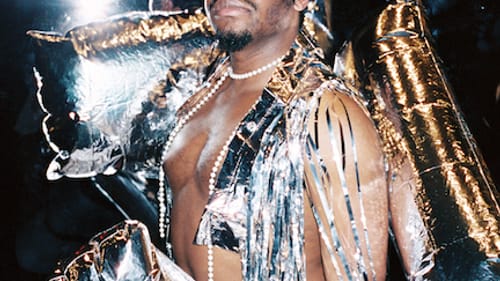Stay in the Loop
BSR publishes on a weekly schedule, with an email newsletter every Wednesday and Thursday morning. There’s no paywall, and subscribing is always free.
Four on the dance floor
American Dance Abroad presents a Philadelphia Dance Showcase

Choreographer Megan Bridge of <fidget> prefaced her program notes for the premier performance of The Backyard (after Nelson/Paxton’s PA RT, 1978-2002) with a Marcel Duchamp quote: “Art is a game between all people of all periods.”
The performance was part of a four-company showcase presented by American Dance Abroad, a Pittsburgh-based global dance initiative sponsored by the Andrew W. Mellon Foundation. The newly renovated and chic Performance Garage hosted the program Thursday night. Sadly, the show, open to the public, was a sold-out one-night stand, really staged for a half-dozen festival presenters from as many countries and VIPs like our former mayor and governor, Ed Rendell.
Bridge’s performance, created with Beau Hancock offered a cherishable, intimate interlude of pure dance, among other more political but equally riveting works. Backyard grew from a residency with choreographer/dancers Lisa Nelson and Steve Paxton. Hancock sat patiently while Bridge, sporting a Duchampian mustache, drew herself up to full height and then variously scrunched herself down into knots before unfurling her languorous arms and slowly spiraling back up. When Hancock joined her, they knit together and oozed apart.
They moved to Robert Ashley’s hypnotic voicings from his 1978 Private Parts, sprinkled with "Blue" Gene Tyranny’s piano echoes. The whole demands deep listening, as required by Ashley’s late contemporary composer Pauline Oliveros, and rigorous attention to the dance shaped by the text. Bridge says, “The Backyard is a palimpsest of Paxton’s PA RT — an effaced manuscript, written over, but still bearing traces of its original form.” I’ll buy that.
Near and far
Matthew Neenan’s Credo, for BalletX, was inspired by the choreographer’s recent travels to India, where he absorbed dazzling new dance ideas. On seeing the occasional bent-knee high kicks and whiplash head turns, I wondered if he’d taken in an Indian Army Hell March. Standing rigidly, the dancers placed one hand on their heads as if trying to shove their bodies like nails through the floor. Other motifs included spyglassed hands on their eyes or skipping high-kneed in perfect sync around the stage. The group, in spice-colored pants and tunics by Reid & Harriet Design, encircled Richard Villaverde (his final dance with the company) as Andrea Yorita drew him out. Chloe Felesina stumbled onstage as if to change the conversation to the more modern sound of Pulitzer-Prize-winning composer Kevin Puts. Modernity won out as Felesina and Villaverde embraced, while Yorita faded offstage.

Jaamil Olawale Kosoko’s Séancers will premiere its 70-minute full version at New York’s Abrons Arts Center in December 2017. On Thursday, Kosoko and co-dancer IMMA performed an excerpt, with sound design by Jeremy Toussaint-Baptiste. The work envelops lyrical poetry by Indira Allegra, Audre Lorde, and Kosoko, whose white-hot glare book, Notes on an Urban Kill Floor — Poems for Detroit, rests atop my poetry stack. Kosoko says Séancers investigates “concepts of black magic, resurrection, and paranormal activity.” Certainly the first costumes, full black and white bodysuits, suggest scarification. A looped refrain, “I have not been able to touch the destruction within me,” comes from Lorde’s poem Power. In my interpretation, scarification may be one way people of color desperately try to scratch out that destruction, as well as being a more obvious reference to certain African tribal rituals.
We’ll have to see the full work to find out where Kosoko takes this. But you can see where the path leads. Kosoko and IMMA pull blonde-wigged masks over their heads. Scarlet-lipped mouths opened in mid-scream, suggesting anything from bank robbers to voodoo dolls to blow-up sex dolls to Ivanka types.
Revisiting Pulse
While all the works had deep, even wrenching emotional meanings that evoked various audience reactions, Kun-Yang Lin’s Santuario, his elegiac dance poem to the 49 dead and 58 wounded victims of last year’s Pulse nightclub murders in Orlando, made me weep. They began the dance as clubgoers that night did: to the club mix “Wake Up,” bleeding out to a soundscape of confusion, rapid gunfire, and screams, ending in Arvo Pärt’s choral music, as composed by Cory Neale.
It was Latino night at Pulse, and some of the women dancers fluttered their hands together like flamenco jaleo, the clapping that calls people to dance. They landed in heaps as so many must have while trying to escape. In the end, they knelt toward us, arms enchained, undefeated.
For their total commitment to this tragedy, I list all the dancers who had to evince this horror. Many, including choreographer Lin, are immigrants, and the dancers are of every sexual orientation: Evalina Carbonell, Liu Mo, WeiWei Ma, Grace Stern, Ani Gavino, Nikolai Mckenzie, Keila-Perez Vega, Frank Leone, and Francis Markocki. I was particularly pleased to see Mu, whom Homeland Security almost barred last year. I wrote a letter on his behalf, and it gobsmacks me that he will have to go through the entire process again next year. What kind of people would want to bar this gorgeous talent from our shores? How could they possibly think he’s a danger, while the shooter at Pulse was actually an unsurveilled American? We should not be bound by ties that blind.
What, When, Where
American Dance Abroad: A Showcase Highlighting Philadelphia Dance. Kun-Yang Lin/Dancers, Santuario; BalletX, Credo, choreographed by Matthew Neenan; Jaamil Olawale Kosoko, Séancers; Megan Bridge, <fidget>, The Backyard (after Nelson/Paxton’s PA RT, 1978-2002), by Megan Bridge and Beau Hancock, and Dust, by Robert Ashley. July 27, 2017, at the Performance Garage, 1515 Brandywine Street, Philadelphia. (215) 569-4060 or performancegarage.org, and americandanceabroad.org.
Sign up for our newsletter
All of the week's new articles, all in one place. Sign up for the free weekly BSR newsletters, and don't miss a conversation.

 Merilyn Jackson
Merilyn Jackson